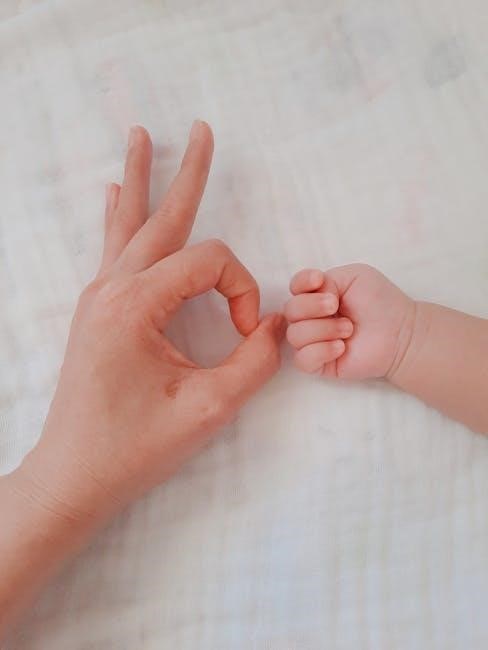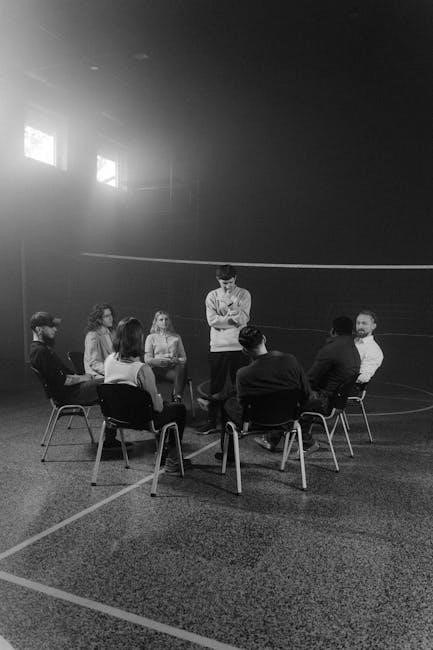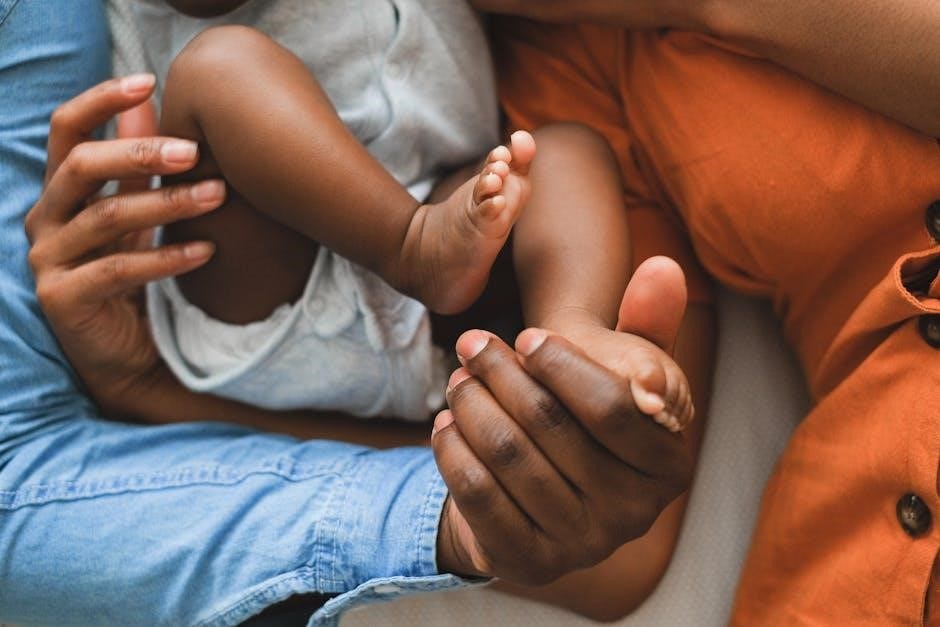Relationship circles are a visual tool mapping social connections‚ categorizing relationships into intimacy‚ friendship‚ participation‚ and exchange. They help identify support networks and strengthen relationships through structured analysis.
1.1 What Are Relationship Circles?
Relationship circles are a visual tool used to map and organize social connections‚ categorizing relationships into distinct levels such as intimacy‚ friendship‚ participation‚ and exchange. They help individuals identify and analyze their support networks‚ fostering clarity and understanding of their personal and professional relationships. This structured approach allows for better communication and boundary setting‚ enhancing overall relationship quality and emotional well-being.

1.2 Historical Background and Development
Relationship circles originated from the work of pioneers like Marsha Forest‚ Jack Pearpoint‚ and Judith Snow‚ who introduced the concept as a tool for support planning and personal growth. Over time‚ it evolved to include practical applications in therapy‚ education‚ and community building‚ becoming a widely recognized method for understanding and strengthening social connections across various contexts.
Structure of Relationship Circles
Relationship circles are organized into four main categories: intimacy‚ friendship‚ participation‚ and exchange. Each circle represents varying levels of closeness‚ interaction‚ and support‚ helping individuals visualize their social connections.
2.1 The Circle of Intimacy
The Circle of Intimacy includes the closest individuals‚ such as immediate family and pets‚ who provide emotional support and are often involved in personal decision-making. This circle represents deep‚ trusting relationships that are vital for well-being and serve as a foundation for other connections. It helps identify gaps in support and focuses on nurturing these critical bonds for a balanced life.
2.2 The Circle of Friendship
The Circle of Friendship encompasses close friends and acquaintances who offer emotional support and shared experiences. These relationships are less intimate than those in the Circle of Intimacy but still provide a sense of belonging and community. Friends in this circle may be involved in social activities and mutual interests‚ contributing to personal well-being and a balanced social life.
2.3 The Circle of Participation
The Circle of Participation includes individuals with whom one interacts in shared activities‚ communities‚ or organizations. These relationships are often based on mutual interests or goals‚ fostering collaboration and networking. While less emotionally intimate‚ they provide opportunities for personal and professional growth‚ contributing to a sense of community and social integration.

2.4 The Circle of Exchange
The Circle of Exchange involves relationships centered on mutual transactions‚ such as professional networks or service providers. These connections are often practical‚ focusing on shared goals‚ support‚ or resources. They provide structure and functionality‚ ensuring a balance between giving and receiving‚ while maintaining clear boundaries to preserve personal and professional integrity.

Practical Applications of Relationship Circles
Relationship circles are widely used in therapy‚ education‚ and community building to improve communication‚ identify support networks‚ and foster personal growth through structured social mapping and analysis.
3.1 Therapy and Counseling
Relationship circles are a powerful therapeutic tool‚ aiding in support planning and communication improvement. They help identify key individuals‚ strengthen relationships‚ and address challenges. Therapists use these visual maps to explore client connections‚ fostering emotional understanding and boundary-setting. This structured approach enhances counseling outcomes by clarifying social dynamics and promoting meaningful interactions.
3.2 Personal Development and Growth
Relationship circles offer insights into personal connections‚ aiding self-reflection and growth. By visualizing relationships‚ individuals gain clarity on intimacy‚ communication‚ and support levels. This tool helps identify areas for improvement‚ fostering intentional relationship strengthening. It encourages boundary-setting and mindful interaction‚ promoting emotional intelligence and healthier social dynamics. Regular use of relationship circles can lead to profound personal development and enriched connections over time.
3.3 Education and Learning
Relationship circles are a valuable educational tool‚ helping students understand social dynamics and boundaries. Educators use these visual aids to teach appropriate interactions based on relationship depth. This approach fosters empathy‚ communication skills‚ and inclusivity‚ benefiting students with diverse needs. Mapping social networks also identifies support gaps‚ enabling tailored interventions for improved learning environments and peer relationships.
3.4 Community Building and Social Networks
Relationship circles are instrumental in building stronger communities by fostering meaningful connections. They help identify shared values and goals‚ creating collaborative spaces for collective action. Visualizing social networks encourages active participation‚ strengthens trust‚ and promotes inclusive decision-making. This tool enhances community resilience by highlighting opportunities for mutual support and shared growth among members.

Tools and Resources for Mapping Relationship Circles
Utilize worksheets‚ PDF guides‚ and digital tools to map relationships‚ identifying key connections and strengthening bonds. These resources provide structured frameworks for visualizing and analyzing social networks effectively.
4.1 The Relationship Circles Worksheet
The Relationship Circles Worksheet is a structured tool designed to help individuals map their social networks. It categorizes connections into circles of intimacy‚ friendship‚ participation‚ and exchange‚ allowing users to visualize relationships and identify areas for support. The worksheet aids in understanding relationship dynamics‚ fostering personal growth‚ and improving communication. It is downloadable as a PDF for easy use.
4.2 Digital Guides and PDF Resources
Digital guides and PDF resources on relationship circles provide comprehensive tools for mapping and analyzing social networks. These resources include detailed worksheets‚ visual diagrams‚ and step-by-step instructions to help users explore their relationships. Available online‚ they offer practical advice for personal development‚ communication‚ and boundary setting‚ making them accessible for anyone looking to enhance their relational skills and understanding.

Cultural and Social Implications
Cultural and social implications of relationship circles vary across societies‚ reflecting collectivist versus individualist values and influencing how connections are prioritized and maintained to foster understanding and unity.
5.1 Collectivist vs. Individualist Perspectives
Collectivist cultures emphasize family ties and community‚ using relationship circles to strengthen group bonds‚ while individualist societies focus on personal growth and autonomy. Tools like the Relationship Circles Worksheet help navigate these differences‚ fostering understanding and support tailored to cultural values‚ though challenges arise in balancing individual and collective needs across diverse social contexts.

5.2 Cross-Cultural Applications of Relationship Circles
Relationship circles are universally adaptable‚ bridging cultural gaps by visualizing connections. In collectivist societies‚ they reinforce community ties‚ while in individualist contexts‚ they aid personal reflection. Tools like PDF guides and digital resources facilitate cross-cultural understanding‚ helping individuals from diverse backgrounds map relationships‚ fostering empathy and cooperation across varied social structures and traditions.
Maintaining and Strengthening Relationships
Relationship circles help individuals nurture connections by identifying key relationships and strategies for growth. Tools like worksheets and guides provide practical steps to strengthen bonds and address challenges effectively.
6.1 Strategies for Nurturing Connections
Strategies for nurturing connections involve active listening‚ empathy‚ and consistent communication. Using tools like the Relationship Circles Worksheet helps identify key relationships and strengthen bonds. Setting boundaries‚ fostering mutual respect‚ and encouraging open dialogue are essential. Regular check-ins and shared activities also deepen connections‚ ensuring relationships remain vibrant and supportive over time.
6.2 Overcoming Challenges in Relationship Circles
Overcoming challenges in relationship circles involves addressing conflicts‚ fostering open communication‚ and setting clear boundaries. Identifying gaps in support networks and strengthening weaker connections is crucial. Using tools like the Relationship Circles Worksheet can help navigate these issues by promoting self-reflection and mutual understanding‚ ultimately fostering healthier and more resilient relationships over time.

Boundaries in Relationship Circles
Boundaries in relationship circles define limits to protect personal space‚ time‚ and private information. They help safeguard emotional well-being and foster trust and respect in relationships.
7.1 Defining Personal Boundaries
Defining personal boundaries involves identifying limits to protect one’s emotional‚ physical‚ and mental well-being. These boundaries vary across relationship circles‚ ensuring trust and respect. They clarify expectations‚ prevent overcommitment‚ and promote healthy interactions‚ fostering a balanced and fulfilling social network. Boundaries are dynamic‚ adapting as relationships evolve.
7.2 Managing Boundaries Across Different Circles
Managing boundaries across relationship circles requires intentional communication and awareness. Each circle—intimacy‚ friendship‚ participation‚ and exchange—demands unique limits. Tools like boundary-setting worksheets help clarify expectations‚ ensuring respect and emotional safety. Regular reflection and open dialogue maintain healthy boundaries‚ balancing intimacy and independence while fostering trust and understanding in diverse relationships.

Digital Resources and Downloads
Digital resources offer downloadable PDF guides‚ worksheets‚ and tools for mapping relationship circles. These resources help visualize and strengthen connections‚ available on official websites and platforms for easy access.
8.1 Free PDF Worksheets and Guides
Free PDF worksheets and guides on relationship circles are widely available online‚ offering structured templates to map social connections. These resources include customizable diagrams‚ tips for visual mapping‚ and exercises to analyze relationship dynamics. They are accessible on official websites‚ education platforms‚ and counseling resources‚ providing tools for personal growth and relationship management. Users can download and print these guides for self-reflection or professional use.
8.2 Online Tools for Visualizing Relationship Circles
Online tools like Canva‚ Lucidchart‚ and Google Drawings offer templates for creating relationship circles. These platforms provide drag-and-drop features‚ customizable designs‚ and collaboration options‚ making it easy to map connections visually. They are accessible on desktop and mobile‚ enabling users to design and share relationship diagrams efficiently for personal or professional use‚ enhancing clarity and organization in relationship mapping.
Case Studies and Success Stories
Online tools like Canva‚ Lucidchart‚ and Google Drawings offer templates for creating relationship circles. These platforms provide drag-and-drop features‚ customizable designs‚ and collaboration options‚ making it easy to map connections visually. They are accessible on desktop and mobile‚ enabling users to design and share relationship diagrams efficiently for personal or professional use‚ enhancing clarity and organization in relationship mapping.
9.1 Real-Life Applications of Relationship Circles
Relationship circles have been successfully applied in therapy‚ education‚ and community building. They help identify support networks‚ strengthen connections‚ and clarify boundaries. For example‚ Marsha Forest used relationship mapping to empower individuals with disabilities‚ while educators employ these tools to foster inclusive classrooms. Such applications demonstrate their versatility in enhancing personal and professional relationships.
9.2 Impact on Personal and Professional Relationships
Relationship circles significantly enhance both personal and professional connections by fostering clarity and deeper understanding. They help individuals identify key supporters‚ strengthen communication‚ and navigate boundaries effectively. In professional settings‚ these tools improve collaboration and teamwork‚ while in personal life‚ they deepen emotional bonds and reduce conflicts‚ leading to more balanced and fulfilling relationships overall.
Relationship circles offer a powerful framework for visualizing and strengthening connections. As tools evolve‚ their integration into digital platforms and therapeutic practices promises enhanced relationship management and personal growth.
10.1 The Evolution of Relationship Circles
Relationship circles have evolved from basic visual tools to dynamic frameworks integrating digital platforms and therapeutic practices. Originating in social mapping‚ they now incorporate advanced techniques for analyzing intimacy‚ friendship‚ and participation. Innovators like Marsha Forest and Judith Snow expanded their applications‚ making them indispensable in personal growth‚ education‚ and community building. Their adaptability ensures continued relevance in modern relationship management.
10.2 Future Trends in Relationship Mapping
Future trends in relationship mapping emphasize digitization‚ AI integration‚ and personalized insights. Tools like interactive PDFs and online platforms will enable real-time tracking and analysis. Virtual reality may enhance visualization‚ while blockchain could ensure data security. These advancements aim to make relationship circles more accessible‚ dynamic‚ and aligned with modern mental health and well-being practices‚ fostering deeper connections and growth.
